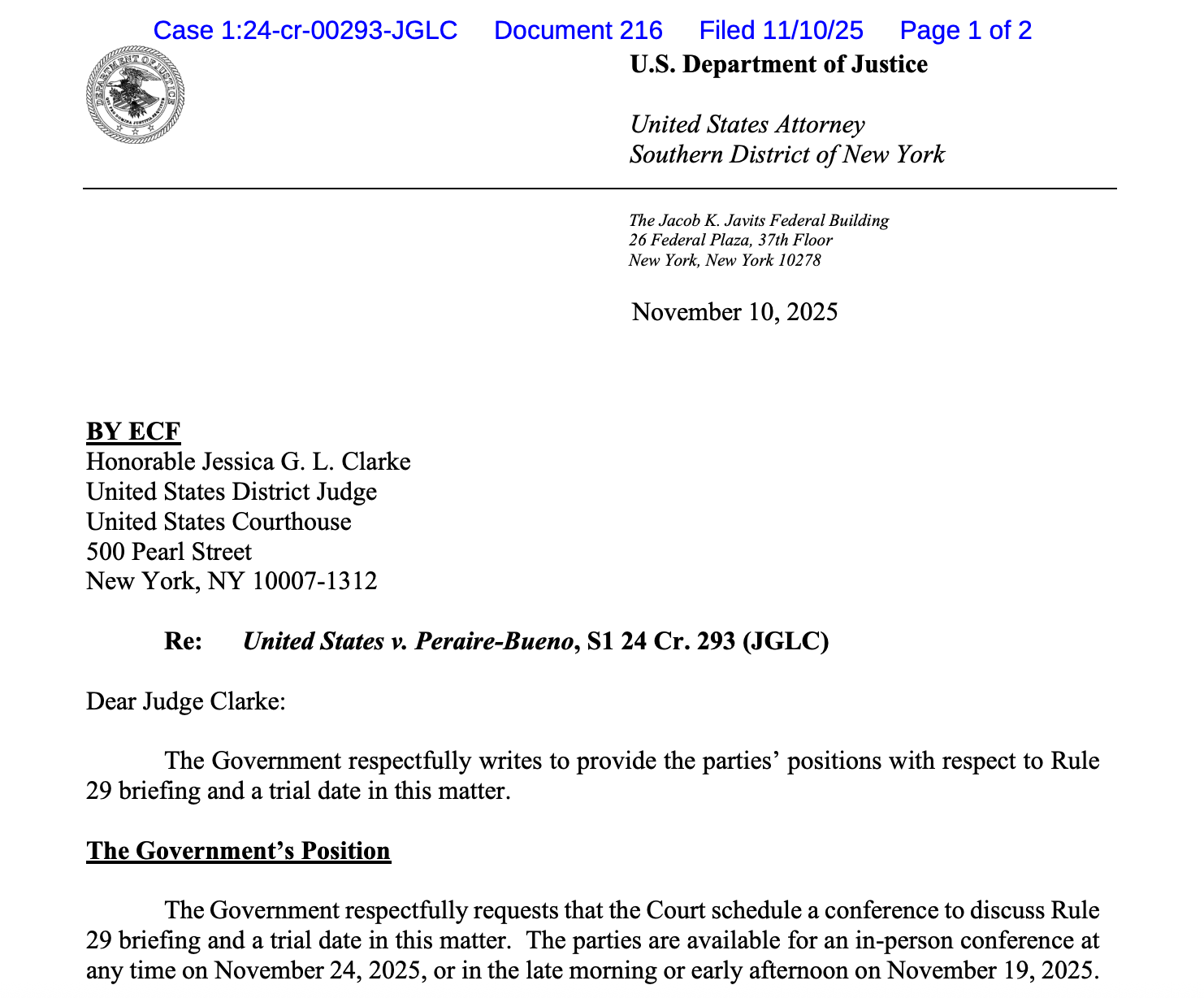The Peraire-Bueno brothers face a potential retrial in early 2026 after a mistrial in their case involving a $25 million Ethereum exploit using MEV bots. Prosecutors in the Southern District of New York seek to retry them for wire fraud, money laundering, and conspiracy charges stemming from the 2023 incident.
-
Mistrial declared: Jury deadlocked after three days of deliberations, unable to reach a verdict on the fraud charges.
-
Retrial timeline: U.S. government requests scheduling for late February or early March 2026 to address the unresolved case.
-
Ethereum implications: The exploit involved manipulating blockchain transactions, raising concerns in the crypto community about trading practices and potential prison sentences of decades if convicted.
Discover the latest on the Peraire-Bueno brothers retrial after Ethereum MEV exploit mistrial. Prosecutors push for 2026 trial amid $25M fraud case. Stay informed on crypto legal developments—read now for key insights.
What is the Peraire-Bueno brothers retrial about?
The Peraire-Bueno brothers retrial centers on allegations that Anton and James Peraire-Bueno orchestrated a sophisticated $25 million exploit on the Ethereum blockchain in 2023 using maximal extractable value (MEV) bots. The brothers, charged with conspiracy to commit wire fraud, money laundering, and conspiracy to receive stolen property, saw their initial trial end in a mistrial due to a deadlocked jury. Prosecutors aim to retry the case in 2026 to seek justice for what they describe as a deliberate manipulation of Ethereum’s transaction ordering for illicit gains.
The Ethereum network, known for its decentralized smart contracts and robust security, became the target of this exploit when the brothers allegedly intercepted and altered pending transactions. This incident highlighted vulnerabilities in blockchain mechanics, particularly in how validators can influence transaction sequencing through MEV strategies. While the crypto industry watched closely, fearing broader regulatory impacts, the mistrial has prolonged the legal battle without resolving the core questions of intent and culpability.

Source: Courtlistener
The U.S. District Court for the Southern District of New York, a key venue for financial crimes, handled the proceedings. Court documents reveal that the jury struggled with complex technical testimony and legal definitions, underscoring the challenges of litigating blockchain-related offenses in traditional courts. If convicted in the retrial, the brothers could face substantial prison time, potentially up to 20 years per count, according to federal sentencing guidelines for such offenses.
Legal experts in cryptocurrency law have noted the case’s significance. “This trial tests the boundaries of innovation versus criminality in decentralized finance,” said a prominent attorney specializing in blockchain regulation, emphasizing the need for clearer guidelines on MEV practices. The Department of Justice’s persistence signals a firm stance against exploits that undermine trust in digital assets.
How does the Ethereum MEV exploit work in this case?
The Ethereum MEV exploit in the Peraire-Bueno case involved deploying bots to monitor the blockchain’s mempool—a temporary holding area for pending transactions—and manipulate their order for profit. By front-running legitimate trades, the brothers allegedly siphoned $25 million in digital assets, including Ether and stablecoins, in a matter of minutes on April 2023. This technique exploits the proof-of-stake consensus mechanism, where validators prioritize transactions that offer higher fees.
Supporting data from blockchain analytics firms like Chainalysis shows that MEV opportunities on Ethereum can generate billions annually, but malicious uses like this one cross into fraud. In 2023 alone, MEV-related extractions totaled over $600 million network-wide, per reports from Ethereum Foundation researchers. The brothers’ method reportedly included creating a false transaction to sandwich a victim’s trade, buying low and selling high at manipulated prices.
Expert testimony during the trial clarified that while MEV is a legitimate tool for optimizing block production, its weaponization here violated securities laws. “The exploit wasn’t just technical; it was a calculated theft,” noted a cybersecurity analyst from a leading blockchain security firm. Short sentences for clarity: The jury grappled with proving intent. Deliberations lasted over three days. Questions focused on “good faith” defenses raised by the defense.
The psychological toll on jurors was evident in court filings. A letter described emotional breakdowns and sleepless nights after nearly a month’s sequestration. This human element adds weight to the retrial’s challenges, as selecting an impartial jury familiar with crypto concepts will be crucial. Financially, the case has already cost the defendants significant legal fees, with public defenders arguing for delays due to resource strains.
Beyond the technical details, the exploit’s aftermath saw rapid responses from Ethereum developers. Proposals to mitigate MEV risks, such as proposer-builder separation (PBS), gained traction post-incident. Statistics indicate that such safeguards could reduce exploitable opportunities by up to 90%, based on simulations from academic studies at institutions like Cornell University.
The broader crypto ecosystem views this case as a litmus test. A conviction could deter similar exploits, while an acquittal might embolden bad actors. Regulatory bodies, including the SEC, have referenced MEV in discussions on market integrity, though no direct enforcement actions followed this specific event beyond the DOJ’s prosecution.
Frequently Asked Questions
What charges do the Peraire-Bueno brothers face in their Ethereum exploit retrial?
The brothers are charged with conspiracy to commit wire fraud, money laundering, and conspiracy to receive stolen property. These stem from their alleged use of MEV bots to steal $25 million from Ethereum transactions in 2023. Conviction could lead to decades in prison, as outlined in federal statutes for financial crimes.
Why did the Peraire-Bueno brothers’ trial end in a mistrial?
The trial resulted in a mistrial because the jury could not reach a unanimous verdict after three days of deliberations. Jurors sought clarifications on testimony and legal terms like “good faith,” and reported emotional distress from the prolonged sequestration, which impacted their ability to decide.
When will the Peraire-Bueno brothers retrial occur?
Prosecutors have requested a retrial as soon as late February or early March 2026 in the Southern District of New York. The judge has yet to confirm the date, but the filing emphasizes scheduling it promptly to maintain momentum in the case.
What are the implications of the Ethereum MEV exploit for crypto trading?
This exploit underscores risks in Ethereum’s transaction ordering, potentially leading to stricter regulations on MEV bots. It affects trader confidence, as similar incidents could erode trust in decentralized exchanges, prompting innovations like enhanced privacy protocols to protect users.
Key Takeaways
- Mistrial outcome: The deadlocked jury highlights the complexity of proving blockchain fraud, delaying resolution but not derailing prosecution efforts.
- Retrial strategy: Expect refined arguments from both sides, with focus on technical evidence to sway a new jury panel.
- Crypto industry impact: This case may accelerate MEV reforms on Ethereum, urging traders to adopt secure practices and monitor regulatory shifts.
Conclusion
The Peraire-Bueno brothers retrial represents a pivotal moment in addressing Ethereum MEV exploits, balancing innovation with accountability in the cryptocurrency space. As the case heads toward 2026, it serves as a reminder of evolving legal landscapes for digital assets. Stakeholders should prepare for potential precedents that could shape future blockchain security—stay vigilant and informed on these developments to navigate the crypto market effectively.
